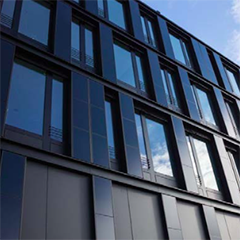ZSW Leads Research Effort into Building-integrated CIGS Solar Modules
Most photovoltaic modules in Germany are mounted on rooftops; very few are integrated into buildings’ envelopes. The Centre for Solar Energy and Hydrogen Research Baden-Württemberg (ZSW) aims to change that with a research project it has been tasked to head up. Joining forces with fellow researchers and industry partners, the ZSW’s scientists are setting out to optimize CIGS thin-film PV for facades. Well suited for integration into buildings, this technology has been a commercial success in rooftop and ground-mounted panels. Now a project is underway to bring to market building-mounted modules. Both manufacturing and system design issues are on the agenda of this project sponsored by the Federal Ministry for Economic Affairs and Energy (BMWi).
Boom-time may be coming soon for building-integrated photovoltaics (BIPV). An EU directive requires all new buildings to be nearly zero-energy by the end of 2020. They will have to be built so that almost no extrinsic energy is required for heating, hot water, ventilation and cooling. Germany has also set its sights on a climate-friendly, carbon-neutral building sector by 2050. These goals will be hard to achieve without facades significantly contributing to the solar yield, which is why experts and scientists predict that architects and building planners will be making greater use of this technology. For German makers of thin-film modules and manufacturing systems, this is an opportunity to capitalize on an emerging mass market.
Helping BIPV break through
“In this research project, we’re looking at the entire system of a thin-film photovoltaic facade,” explains Dieter Geyer, project manager at ZSW. “We’re optimizing the module’s design for energy yield, shadow tolerance, installation ease, and flexibility in module size, and we’re adapting it to the system’s other components.” ZSW researchers are investigating the electronic components’ safety, functionality and reliability. They are also examining CIGS facades’ energy efficiency potential to determine how the building itself can meet electrical power and thermal energy demands.
ZSW is performing the design calculations, conducting lab and field tests, and collecting operating data. Its researchers are assessing and comparing the different system’s performance and yield in field tests on the CIGS facade at the institute’s new building in Stuttgart and at the Widderstall testing facility. These operating data will be loaded to a simulation to help researchers determine to what extent CIGS facade systems can cover the demand for electrical power in different types of buildings. The project will also look at rear-ventilated, PV double facades and heat pumps. The designated partners aim to manufacture the optimized facade-mounted modules and system components when the project is concluded.
The ZSW’s partners in this endeavor are the Research Centre for Sustainable Energy Technology at the Stuttgart University of Applied Sciences and Manz CIGS Technology. Associated partners include AVANCIS, Gartner Instruments, KACO new energy, SMA Solar Technology and SolarEdge Technologies.


























